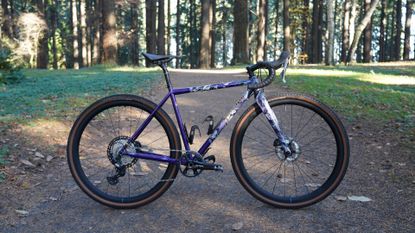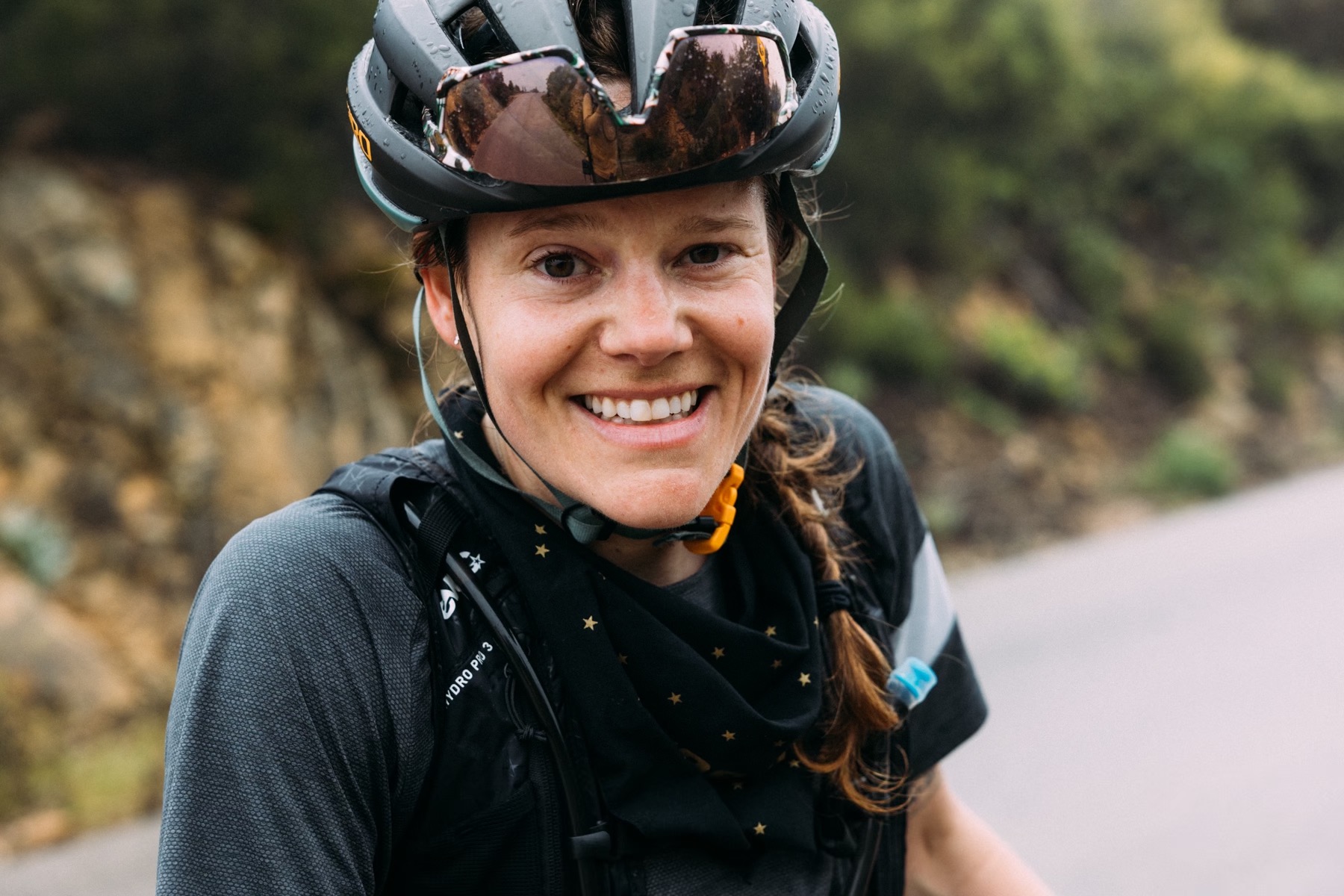A little piece of Colombia in your garage: a custom Scarab Paramo gravel bike reviewed
Made to measure, with stunning paint and a stable, reliable ride – the Scarab Paramo is a striking steel steed

In a world where bikes aren't just machines but extensions of personal expression, Scarab Cycles offers trusty companions made with passionate craftsmanship, a tailored geometry, a curated customer process, lifelong materials and stunning paint.
-
+
Custom geometry
-
+
Personalized, high quality paint
-
+
Curated customer involvement
-
+
Proven materials
-
+
Incredibly fast lead times
-
-
A little weighty
You can trust Cycling Weekly.

The team at Scarab Cycles firmly believes "in the scientifically proven principle that if a bike looks good, you're going to want to ride." Indeed, with their bright colors, intricate stenciling, marble dips and meticulously hand-painted art, Scarab bikes have quickly become a favorite at handbuilt bike shows and expos around the world.
The paint is an absolute standout, but that is only part of the package that this Colombian bike brand has to offer.
Meet Scarab Cycles

Nestled in Retiro, Antioquia, a quaint community just an hour and a half south of Medellín, Scarab Cycles is the brainchild of Santiago Toro, formerly of Tinno Cycles.
Toro founded Scarab in 2018 with the aim of crafting high-quality, custom-made bike frames with proud Colombian flare, competitively priced to challenge mass-produced carbon frames.
In its short five years of existence, Scarab has become a respected, professional workshop that churns out six custom steel framesets weekly, which are sold directly to consumers and through select boutique stores worldwide, including a dedicated Scarab pop-up in Miami, Florida.
Rather than building a brand around one specific frame builder, Toro built a team of craftspeople around his brand, hiring and training young locals in the art of bicycle manufacturing as a way to support the local economy and job force.
Scarab offers eight bike models across the road, all road, gravel and mountain bike disciplines, each made with Columbus, PegoRichie or Kaisei steel tubing. Why steel? "Because it provides the perfect balance between ride quality, durability and weight," says Toro. "Steel provides a unique feeling of the road. It smoothes out the harshness of the surface while transferring power in a unique way."
At Scarab, customization is king. The existing models are merely a starting point as the bike's geometry, build kit and paint are unique to each customer. Through design meetings with the customer, Toro and his team aim for "telepathic handling" – a bike so tuned to the rider's needs that it feels like an extension of the rider rather than a tool.

The in-house paint for which Scarab is quickly becoming known is led by designer Alejandro Bustamante. In his hands, the frame becomes a canvas, ready to be hand-painted, dipped, or stenciled into a piece of rideable art that reflects the personality of its new owner.
Beyond the craftsmanship, Scarab proudly embodies Colombia's spirit. Each bike model was crafted and named for a specific topography or terrain of the vibrant country, and many finished bikes go out into the world adorned with the yellow, blue and red ribbons of the country's flag. What's more, with the purchase of a Scarab bike comes a heartfelt invitation to visit and explore a country where cycling is considered a source of national pride.
It's not too often that we get to review a custom bike, let alone go visit the makers at their home facility in a faraway country, but Scarab gave us the opportunity to do both. See how Scarab bikes are made here.
The Scarab Paramo

The Paramo is Scarab Cycles' gravel model. A bike that, Scarab says, was designed out of necessity rather than fashion, given that only an estimated 10% of Colombia's roads are paved. With the Paramo, Scarab set out to design a bike that could navigate the country's challenging, off-road terrain capably and comfortably.
Its name comes from the extensive high-altitude ecosystem that can be found above the tree line in the Andes Mountains. It's "a place where nature evolves at one of the fastest rates on Earth, a place of staggering diversity and stark, barren beauty. Coincidentally, it's a place where few venture, perhaps because of the thinness of the air and absence of paved roads," the Scarab website states.
Made to tackle rugged terrain, the frame sports a blend of Columbus Spirit and Life tubing "to achieve comfort," a Columbus carbon fork, clearance for 700c x 45mm or 650b x 50mm tires, disc brakes, and mounts for a third water bottle on the downtube and accessory mounts on the top tube.
The Paramo - overview:

- Tubing: Columbus Spirit and Life blend
- Fork: Columbus Futura Carbon
- Tire clearance: 45mm x 700c, 50mm x 650b
- Paint: in-house and fully custom
- Disc brakes only - 25mm flat mount bolts
- Third bottle cage mount included. Fender mounts available upon request.
- English threaded BB
- 27.2 seatpost
- Frames start at $3400
Geometry

Rook's geometry for her Scarab Paramo test bike
As is customary in their process, I met with the Scarab team via video meetings to get to know one another, talk about my background in cycling, and discuss what I want out of a bike and my desired geometry. I'd gone through the custom bike geometry process before, so I know quite well what I do and do not like. I also had bike measurements on hand, so the geometry portion of the design process went rather quickly. When it comes to gravel riding, I enjoy it all: bikepacking, regular jaunts through a local park, some singletrack as well as the occasional ultra-long challenge. Given the steel material, for this bike, capability and comfort would trump speed. Even so, I was still looking for agility and playfulness in the bike's handling.
The finished result fits me well. It has a longer wheelbase and is generally a bit more elongated than my go-to bikes; thus, I am running a shorter stem than I usually do. Begrudgingly, I even had to add a riser stem for positioning comfort after a recent injury to my torso.
Still, the handling is pleasantly agile and perfectly capable of handling some twisty singletrack. And despite the shorter stem, what's most remarkable about the geometry is that when I get out of the saddle for a sprint or to climb, my knees easily stay clear of the handlebars – something I usually have to watch out for.
Aside from the stem change, the bike fit needed no adjusting, which is, of course, the beauty of going custom.
Paint

My favorite yet also the most intimidating part of the process was getting to design the bike's colorway. Approaching a bike as a blank canvas can be a tad daunting, but Alejandro was really fun to work with. He encouraged me to peruse Scarab's previous works to see what the in-house painting department is capable of and to bring him examples of patterns, colors and designs that speak to me. The initial phase, he said, was simply to "to understand you."
I quickly decided on a theme: reclaiming purple. I've been in the bike industry long enough to remember the "pink it and shrink it" days, where all women-oriented products were pink and purple. I also have a twin brother, so my entire life, I was told blues and green were for him, pinks and purples for me. As such, these became rather loaded colors for me. It took me years to come around on the color but I do actually quite like purple. And even some pinks. So the idea for the paint was to go all in on purple paired with the marbled forks I've seen Scarab do in the past. Alejandro was all about it, and the paint job turned out fantastic. It is quite the head turner and sadly for you readers, the dark, sparkly purple and multicolor marble are best appreciated in person.
The whole process was welcoming, fun and impressively quick. From signing off on the geometry to receiving the finished product at my doorstep in the U.S. took just five weeks. That lead time is almost unheard of in the handbuilt bike world.
The Build

Once I received the frameset, I built it up with Shimano's new and capable 12-speed GRX 820 groupset in a 1x configuration with a 10-45T cassette and 40T chainring. It's rolling on the new Shimano RX880 carbon gravel wheels, and the finishing kit includes a PRO carbon seatpost, PRO PLT Compact Ergo aluminum handlebar, aluminum stem, Elite bottle cages and the Cadex amp saddle.
Ready to ride, it weighs in at 21 lbs.
The Ride

Due to injury, my first real rides on this steel beauty were, fittingly, in Scarab's backyard in the Antioquia region of Colombia. I immediately fell head over heels in love with the landscape, the people, the varied terrain and the riding.
The road surface varied in ruggedness, but wherever we went, climbing was guaranteed. From the worn cobblestones of the colonial towns to the rough, twisty paths winding up mountains, around countryside landscapes and coffee plantations, gravel biking in Colombia is a mesmerizing adventure that immerses you in the essence of a country in a way only a bike can.
In a setting like that, it's easy to also fall in love with the trusty steed that guided you there. And indeed, the Scarab is well-built and more than up for the task, maneuvering capably, taking the beating in stride and absorbing the rough terrain. It felt stable, robust and reliable throughout. For bikepacking and adventuring where there are plenty of unknown, the Paramo would be a trusty companion.
From a performance or fast-gravel point of view, there is some weightiness to the bike, especially in the rear, that can be felt when the roads point up. I ride a relatively small bike and at that, the Paramo –21 pounds, fully built up with high-end specs– is a solid 4 pounds heavier than my carbon gravel steed.
However, I feel that in the unpredictable and rough nature of gravel riding, handling, comfort and durability play a more significant role than pure bike weight. Steel is a wonderful choice for gravel steeds due to its damping characteristics. It takes the sting out of rough surfaces and provides a smoother, comfortable and controlled ride experience. On a long, bumpy days in the saddle —both in Colombia and at home— my body is grateful for the stability and comfort the Paramo offers.
Value & Verdict

A Paramo frameset starts at $3,400, which is certainly an investment. But considering the tailored geometry, proven craftsmanship, curated customer process, lifelong materials and fully custom paint job, I think it's also a very good price. The paint alone is worth a pretty penny. Many bike builders outsource their paint, and something of Scarab's quality can set you back a grand or two with ease.
In a world where bikes aren't just machines but extensions of personal expression, Scarab Cycles offers fine craftsmanship and a little piece of Colombian art to explore the paths less traveled.
Gallery













Thank you for reading 20 articles this month* Join now for unlimited access
Enjoy your first month for just £1 / $1 / €1
*Read 5 free articles per month without a subscription

Join now for unlimited access
Try first month for just £1 / $1 / €1
Get The Leadout Newsletter
The latest race content, interviews, features, reviews and expert buying guides, direct to your inbox!

Cycling Weekly's North American Editor, Anne-Marije Rook is old school. She holds a degree in journalism and started out as a newspaper reporter — in print! She can even be seen bringing a pen and notepad to the press conference.
Originally from The Netherlands, she grew up a bike commuter and didn't find bike racing until her early twenties when living in Seattle, Washington. Strengthened by the many miles spent darting around Seattle's hilly streets on a steel single speed, Rook's progression in the sport was a quick one. As she competed at the elite level, her journalism career followed, and soon she became a full-time cycling journalist. She's now been a cycling journalist for 11 years.
-
 In search of the world's best club jersey: Jubilee Park CC v Kibworth Velo Club
In search of the world's best club jersey: Jubilee Park CC v Kibworth Velo ClubEvery week we pit two club kits against each other and you get to vote on the best designs
By James Shrubsall Published
-
 'I had to wait at the top of every hill' – the highs and lows of Malcolm Elliott's career in the fast lane
'I had to wait at the top of every hill' – the highs and lows of Malcolm Elliott's career in the fast laneThroughout his two-part career, no-one epitomised Sheffield steel like Cycling Weekly's 2023 Lifetime Achievement award winner Malcolm Elliott
By James Shrubsall Published
-
 'I never wanted to be known as the TikTok cyclist' - how Alison Jackson wrote her legacy at Paris-Roubaix
'I never wanted to be known as the TikTok cyclist' - how Alison Jackson wrote her legacy at Paris-RoubaixThe Canadian tells Cycling Weekly how a day across the cobbles of northern France changed her career
By Tom Davidson Published


